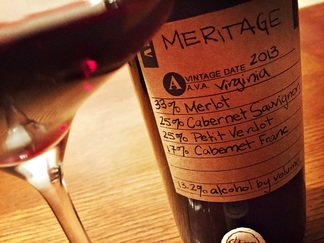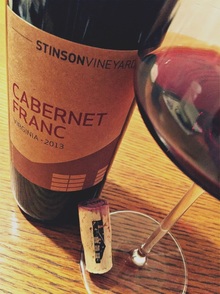 Every once in awhile I receive an unexpected sample from a region with which I don’t have a lot of familiarity. This was the case with Stinson Vineyards in Virginia. Of course, I was curious because I have not tasted very many wines from this part of the country. Doing a bit of research on Stinson Vineyards, I learned that the small family estate is situated in Virginia’s Blue Ridge wine-growing region near its namesake Blue Ridge Mountains, located on the western side of the state. In the Blue Ridge region and spread across the other wine-growing regions in the state, new vineyards have been planted and new wineries have been established over the last thirty or so years. There are more than 250 wineries now throughout the state. Stinson Vineyards was formed in 2009 with the purchase of the property. On the estate, the Piedmont House is the historic icon of the property. It was originally built in 1796 and is now surrounded by vineyards, the sites of which were originally planted with vines as long as forty years ago. Although the vineyard was out of commission for a while, Viticulturist and Vineyard Consultant, Lucie Morton, helped the Stinsons bring the vineyards back to life with new plantings in 2009. Seven of the original twelve acres have been replanted with Sauvignon Blanc, Chardonnay, Petit Manseng, Cabernet Franc, Petit Verdot, Merlot, Cabernet Sauvignon and Tannat. Along with grapes purchased from other regions in Virginia, Stinson crafts their wine collection in combination with the the grapes from this estate vineyard. In the cellar, father Scott Stinson and daughter Rachel Stinson are inspired by traditional French techniques, implementing practices such as whole berry fermentation for their red wines and ageing on lees for their white wines. The winery itself was designed by Scott (who just so happens to be an architect) and built atop a three-car garage, hearkening to the concept of garagiste wines. Their quaint tasting room offers guests a chance to taste wines as well as shop their farm products, such as grass-fed beef, farm-raised pork and chicken, free range organic eggs, local produce and garden fresh herbs. Currently, Stinson Vineyards offers a roughly 2,000-case collection of wines: for whites, a Sauvignon Blanc, Chardonnay and Vidal Blanc; a Rosé of Mourvédre; and for reds, a Cabernet Franc and Meritage blend. The two samples I received were of the two reds.  I enjoyed the straightforward and easy-going style of the 2013 Cabernet Franc. A bit shy on the initially herbal nose, with aromas of mint and faint black olive, spiced fruit and candied red cherry evolved with time. In the mouth, this Cabernet Franc is juicy and lighter bodied in a Loire Valley style, with a lot of spice on the mid-palate. There are hints of blue fruit coming through the red fruit nuances of this simple and enjoyable wine. The wine spent eight months in 20% new French oak and a small 175 cases were produced. Its gentle new oak restraint makes this wine very friendly for the dinner table. The 2013 Meritage was a bit more rustic on the nose, with an almost brine-like, salty character. Much tastier on the palate, this Bordeaux blend composed of 33% Merlot, 25% Cabernet Sauvignon, 25% Petit Verdot and 17% Cabernet Franc was smooth and mouth-filling—a sign of that Merlot dominance. In the mouth, a bit of menthol-like, herbal flavors show just underneath the cherry and blueberry fruit. The wine spent 18 months in 30% new French oak and only 275 cases were made. Tasting these wines was a welcomed introduction to Virginian reds.
0 Comments
Leave a Reply. |
Wine Blog Archives
December 2020
|